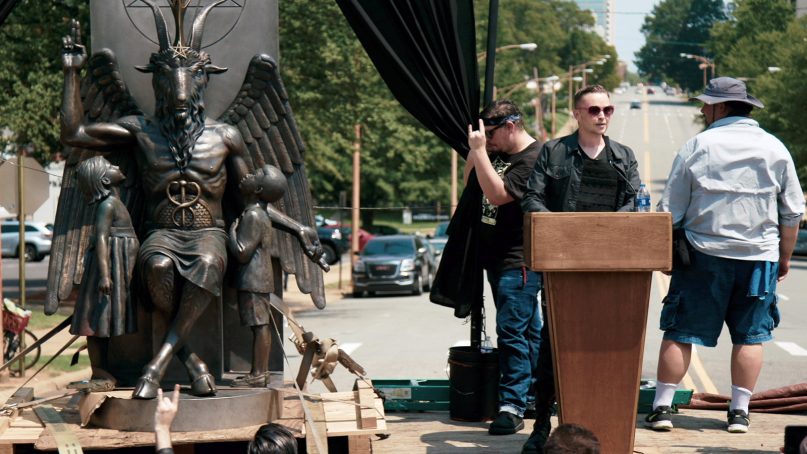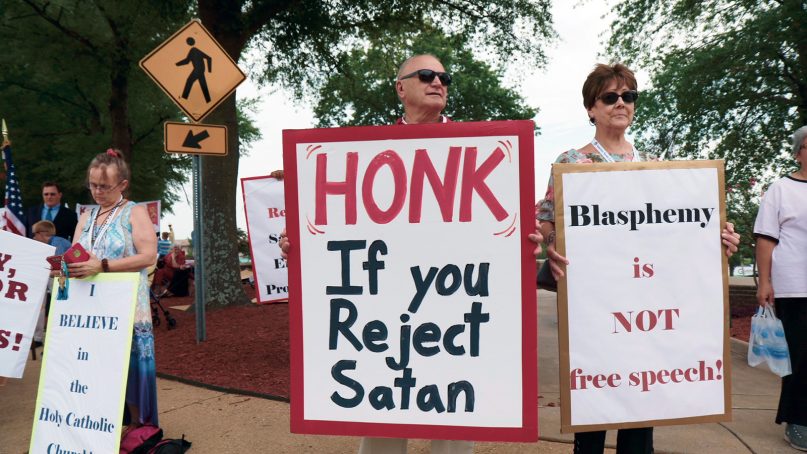
(RNS) — The Almighty may not think the Satanic Temple is a church.
But the taxman has given it the thumbs-up.
The Satanic Temple, which is featured in a documentary called “Hail Satan?,” announced this week that the IRS now recognizes it as a church.
That recognition means the group can now get the same benefits as religious organizations — including tax exemption and protection from discrimination.
In a statement, Lucien Greaves, founder of the media-savvy group, said that “accepting religious tax-exemption — rather than renouncing it in protest — can help us to better assert our claims to equal access and exemption while laying to rest any suspicion that we don’t meet the qualifications of a true religious organization.”
“Satanism is here to stay,” he added.

Lucien Greaves speaks in front of the state Capitol in Little Rock, Ark., in August 2018, next to a statue of Baphomet. The Satanic Temple wanted to install the statue as a symbol for religious freedom. Photo courtesy of Magnolia Pictures
A member of the Temple made a similar claim in the trailer for “Hail Satan?,” which details the nonprofit’s attempts to put up a statue of Satan on public grounds.
“I am following a code of ethics, having fellowship with brethren. Why can’t I be a religion?” he said.
It’s a question that religion scholars have long debated, said Benjamin Zeller, associate professor of religion at Lake Forest College who studies new religious movements.
“Scholars who spend their lives researching and teaching religions still can’t agree on this,” he said. “When I teach this in class, I always compare it to art. Artists might spend their lifetimes doing art but couldn’t come up with a formal definition of what is art.”
As courts wrestle with the First Amendment implications of what is — and isn’t — a religion, scholars who study religion agreed that the term is slippery.
One person’s religion is another’s hogwash. Even religions with centuries of seniority, which are grandfathered into the “real” religions club, often have adherents in the pews (or online) who disagree over who can say what it means to be part of a faith group.
Even Satanists disagree over who the true faithful are. The Satanic Temple’s website features a section that contrasts its work with the Church of Satan.
Meanwhile, grandfathered-in religions were once denounced as cults.

Protesters hold signs against the Satanic Temple in Little Rock, Ark., in August 2018. Photo courtesy of Magnolia Pictures
Zeller assigns his students to read the second-century letter that Pliny the Younger wrote to Emperor Trajan about early Christianity.
“This Roman governor is complaining about the Christians and using all this anti-cult language,” Zeller said. “He says that they have these secret gatherings, they’re stealing children from families, they’re engaged in weird sexual practices, and they’re disrupting the social order. Just replace ‘early Christians’ with whatever your current cult fear is.”
Yet all things being equal, Americans tend to give credence to older religions, even if they think them odd or don’t understand them.
“We are willing to begrudgingly accept that they belong at the religion table, whatever that is,” Zeller said.
Matthew Bowman, associate professor of history at Henderson State University who has written widely on the Church of Jesus Christ of Latter-day Saints and is author, most recently, of “Christian: The Politics of a Word in America,” thinks Mormonism is an effective barometer with which to measure what Americans think are real and fake religions.
When Joseph Smith was alive, the founder of the LDS church, who was killed in 1844, was considered a con man, so Mormonism was considered as a great swindle by many in the public.
When the church’s members became established in Utah, their faith was thought of as a political movement, and in the 20th century, Mormonism was thought of as a business, according to Bowman.
Now Latter-day Saints are seen as fairly mainstream.
Americans judge the merits of Latter-day Saints and other faith groups — including Roman Catholics — using the nation’s dominant theology as a template, according to Bowman.
“We tend to think of religion in Protestant terms. That is: Real religion is something about belief,” he said. “Groups that don’t fit that category are often suspect.”
Zeller agrees that Americans’ Protestant expectations are that religions must have beliefs and some sort of deity or deitylike being, and its adherents need to take it seriously.
“It has to be at the center, a sort of structure and identity in your life,” he said. “So that would mean sort-of joke religions and things that come out of fiction, perhaps, shouldn’t count. And that’s when it gets really interesting.”

A satanic ritual in Los Angeles shown in the new documentary “Hail Satan?” Photo courtesy of Magnolia Pictures
From Jediists — inspired by “Star Wars” — to the Church of the Flying Spaghetti Monster to the Church of Body Modification, whose members view tattooing as a spiritual practice, there are a lot of groups that resist definition if one adopts a Protestant approach.
“What if I say, ‘God talked to me yesterday and said I should smoke dope in public.’ Do the courts have to take me seriously?” Zeller said.
Bowman noted that some countries allow people to declare themselves Jediists on censuses.
“To what extent does the public, or does the state, have an interest in judging is the Church of the Flying Spaghetti Monster or of the Jedi a legitimate or not legitimate religion?” he said. “Is that something that we want the government to be ruling on?”
And saying that actual belief is a litmus test won’t do. Bowman’s dissertation adviser, a self-declared atheist, bar mitzvah-ed his son, Bowman said.
Marc Stern, general counsel at the American Jewish Committee, sees the legal question of what is and isn’t a religion as somewhat of a moving target at the moment.
“Law professors love to play with this question,” he said. “In practice, it’s usually not all that hard. Most people who claim to be religious are recognizably so.”
In Oklahoma, the Satanic Temple tried to install a statue of Baphomet — a goat-headed, winged Satanic figure — after lawmakers there approved a Ten Commandments monument. The Satanic Temple, which claims 100,000 members online, argued for equal access.
The state Supreme Court eventually ruled the Ten Commandments monument was unconstitutional.
In Massachusetts, Satanists filed suit after their request to offer an invocation during Boston City Council meetings was denied.
They are drawing on a 2014 U.S. Supreme Court case, Town of Greece v. Galloway, which upheld a practice of beginning board meetings with prayers.
“At least as the court viewed it, it wasn’t out of any intent to limit attendance to Christians. It was just somebody pulled the phone book and looked through it,” Stern said. ‘The court’s opinion suggests that if there were a deliberate attempt to exclude one or the other religious group, that would be a different story. And the Satanists are playing on that thing.”
But even if questions about what’s a religion and what’s a cult have been asked for decades, Americans are thinking about religion in different ways today, according to Stern, who points to University of Virginia School of Law professor Micah Schwartzman’s 2012 article “What if Religion Isn’t Special?”
“That’s a change that has occurred in the time that I’ve been doing this. It used to be even people who opposed religious accommodation understood that religion played a special role in people’s lives. That’s gone for many people,” Stern said.
There’s widespread Democratic support in Congress for amending the Religious Freedom Restoration Act. And in Europe, the view of religion as nothing special has led to serious threats to shechita, Jewish ritual kosher slaughter, and to traditional Islamic attire.
Some make the argument that eliminating exemptions will avoid the difficult question of defining what is and isn’t a religion. But that won’t end legal debates over religion.
“You can’t escape those questions if you’re going to address religion,” he said. “If you have any provision touching on religion, you’re going to have to decide what’s in and what’s out.”
As “Hail Satan?” director Penny Lane told Vox, she initially thought the film was about people mocking religion, only to learn it was about religion.
“I loved the idea of watching a new religion get born, right before our eyes, and how goofy and weird that looks, especially if you’re not part of it,” she told Vox.
